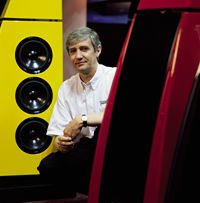For the Love of Music
He is the softspoken firebrand of DVD-Audio, the implacable advocate of digital's superiority over analog, the tireless refiner of those benchmark loudspeakers and electronics that bear the name Meridian. Robert Stuart has been a man on a mission since his university days in Birmingham, England, when he cobbled together a tape recorder so he could enjoy music at school. From the founding of Meridian in 1977 to the unveiling of its most ambitious (and expensive) new products, Stuart has been driven by the same passion that inspired his college tape deck. "I believe that if you can remove the barriers represented by the playback system," he explains in his quiet, measured fashion, "its performance will be more like the real event, the concert."
 For 25 years, Bob Stuart has pressed Meridian onward, toward the Holy Grail of sound as musical truth. He is the company's chairman, chief designer, and dauntless visionary. Together with industrial designer Allen Boothroyd, his collaborator at Meridian from the start, Stuart has produced a consistently stellar line of DVD players, processors, and powered digital loudspeakers. His belief in digital as the one true path also led him to spearhead the international committee that formulated the audio standards for DVD. Even as the entertainment landscape changed around him, and movies supplanted music as the focus of multichannel audio, this 53-year-old native of Belfast, Ireland, has remained a music man at heart. Only when you begin with music, Stuart insists, can you end up with a sound system that works for everything.
For 25 years, Bob Stuart has pressed Meridian onward, toward the Holy Grail of sound as musical truth. He is the company's chairman, chief designer, and dauntless visionary. Together with industrial designer Allen Boothroyd, his collaborator at Meridian from the start, Stuart has produced a consistently stellar line of DVD players, processors, and powered digital loudspeakers. His belief in digital as the one true path also led him to spearhead the international committee that formulated the audio standards for DVD. Even as the entertainment landscape changed around him, and movies supplanted music as the focus of multichannel audio, this 53-year-old native of Belfast, Ireland, has remained a music man at heart. Only when you begin with music, Stuart insists, can you end up with a sound system that works for everything.
"You can't start with the Grateful Dead or Jurassic Park and then see how it all does with a solo violin," says Stuart. "If you begin with acoustical music as the reference point, you can work to create a sound that's entirely believable in your own listening space, your living room. That's no easy thing. The truth is, a piano or chamber ensemble or small chorus performing in your living room would produce a very great amount of sound. But at least it's possible to reproduce a credible likeness of that experience."
The trick—the challenge for the type of integrated digital systems Stuart keeps honing—is "to make sure that impression doesn't fall over when a level of abstraction is introduced, something bigger and inherently less plausible, like a choir or an organ or a symphony orchestra. We know such a thing could never actually perform in our living room, but we want to be able to believe in the reality of that reproduced performance."
Central to achieving this hard-won illusion, in Stuart's view, is the science of psychoacoustics, which examines the complex ways in which the human brain "hears"—specifically, how it interprets the sonic components of music. "There are all kinds of wacky theories about the way we hear," he says. "We certainly don't have all the answers, but the pursuit is fascinating. Just consider, on a perceptual level, how the brain streams the four sonic factors of a string quartet into a single sound in our mind. Now consider how that process is altered when the source changes from a pair of loudspeakers, located to the left and right in front of us, to several speakers positioned around the room. This is a very important issue: In the last generation, we've had to unlearn listening in 2-channel stereo."
Make no mistake, Robert Stuart is not a 2-channel kind of guy. He lumps the notion of "pure" right-left stereo in the same bin of folly with the intrinsic superiority of analog. Two-channel became the definition of stereo for one reason only, Stuart notes: A vinyl record groove has two sides, and that was the marketing medium for stereo. Indeed, Stuart contends it was the same limitation in the LP that foiled the multichannel experiment in the 1970s. Mr. Meridian is a dyed-in-the-wool multichannel enthusiast. From where he sits, the next frontier of surround sound is the height channel.
"I've always felt passionately that height must be the next thing. It may take a while, but I think we'll see it. Once you've heard it, you really feel it's another big step forward. The height component of sound is something we experience in live concerts, of course, but it's also right there in everyday life. It's a normal source of our entire sound world."
Before you cringe at the structural threat—and expense—of suspending a couple of Meridian's DSP8000 speakers from the ceiling, understand that Stuart sees the height channel as an easily managed last piece of a totally enveloping sound bubble. "Small speakers—a pair or two pair—near the ceiling should do very nicely," he says. "There can be bass in the height channel, but bass isn't the most important thing. High-frequency information is what you're looking for there."
























































